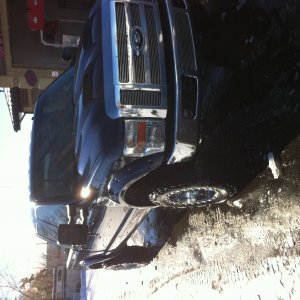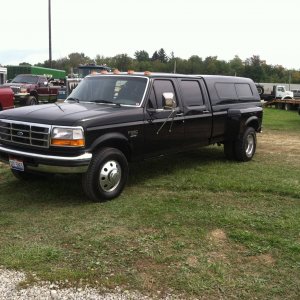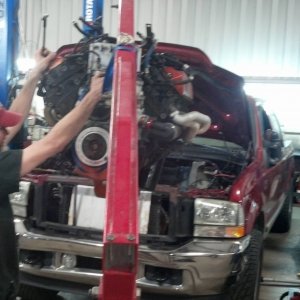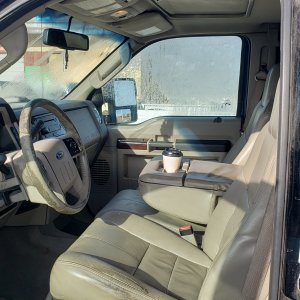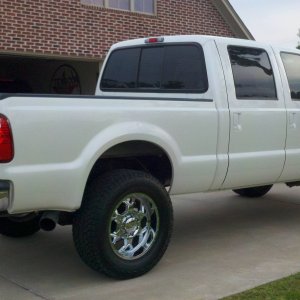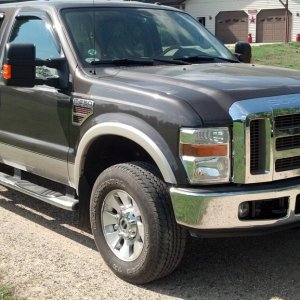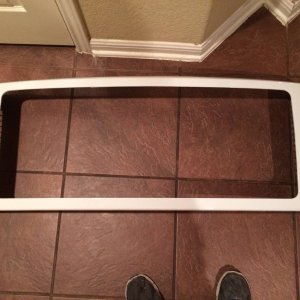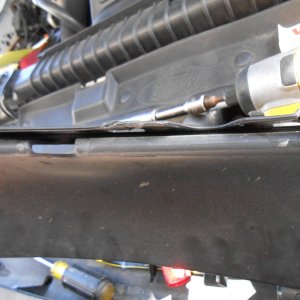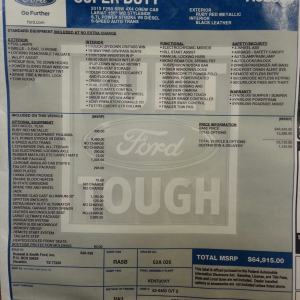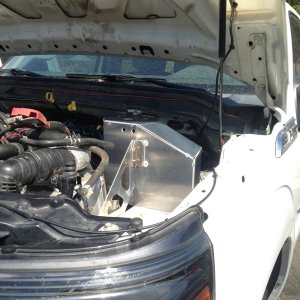Not to argue with you but i worked for exxon/mobil offshore division for 9 years. I asked a old coworker of mine who happened to be a petroleum engineer when i wanted to run jet A in my 7.3. That is what he told me to use and the mix to use. So i went with it , he has a degree from texas A&M in petroleum engineering so i wasnt going to argue ... thats was good enough for me.
Tell him he needs to go back to school...MM is worse than using used motor oil in your fuel tank...PROVEN!
The following are the preliminary results of a research study on diesel fuel Lubricity Additives. There is likely to be further commentary and explanation added at a future time.
PURPOSE:
The purpose of this research was to determine the ability of multiple diesel fuel additives to replace the vital lubricity component in ULSD (Ultra Low Sulfer Diesel) fuel.
HISTORY:
ULSD fuel is the fuel currently mandated for use in all on road diesel engines. This fuel burns cleaner and is less polluting than it’s predecessor, called Low Sulfer Diesel Fuel. Low sulfer fuel contained less than 500 ppm of sulfer. ULSD contains 15 ppm or less.
As diesel fuel is further refined to remove the polluting sulfer, it is inadvertently stripped of its lubricating properties. This vital lubrication is a necessary component of the diesel fuel as it prevents wear in the fuel delivery system. Specifically, it lubricates pumps, high pressure pumps and injectors. Traditional Low sulfer diesel fuel typically contained enough lubricating ability to suffice the needs of these vital components. ULSD fuel, on the other hand, is considered to be very “dry” and incapable of lubricating vital fuel delivery components. As a result, these components are at risk of premature and even catastrophic failure when ULSD fuel is introduced to the system. As a result, all oil companies producing ULSD fuel must replace the lost lubricity with additives. All ULSD fuel purchased at retail fuel stations SHOULD be adequately treated with additives to replace this lost lubricity. The potential result of using inadequately treated fuel, as indicated above, can be catastrophic. There have been many documented cases of randomly tested samples of diesel fuel. These tests prove that often times the fuel we purchase is not adequately treated and may therefore contribute to accelerated wear of our fuel delivery systems. For this reason it may be prudent to use an after market diesel fuel additive to ENSURE adequate lubrication of the fuel delivery system. Additionally, many additives can offer added benefits such as cetane improver, and water separators or emulsifiers.
CONTENT:
In this study we will test multiple diesel fuel additives designed to replace lost lubricity. The primary component of this study is a side-by-side laboratory analysis of each additive’s ability to replace this vital lubricity. Additionally, claims of improving cetane, water separation or emulsification, bio-diesel compatibility and alcohol content will be noted. These notes were derived from information that was readily available to consumers (via the label and internet information) and none of this information has been evaluated for validity and/or performance. Cetane information has only been noted if the word “cetane” was used in the advertising information. The words “improves power” has not been translated to mean “improves cetane” in this evaluation. Information on alcohol content is provided by indicating “contains no alcohol”. Omission of the words “contains no alcohol” does not imply that it does contain alcohol. This information was simply missing in the information available to a consumer. However, the possibility of a form of alcohol in these products is possible. Additionally, information on dosages and cost per tankful are included for comparison purposes.
How Diesel Fuel Is Evaluated For Lubricating Ability:
Diesel fuel and other fluids are tested for lubricating ability using a device called a “High Frequency Reciprocating Rig” or HFRR. The HFRR is currently the Internationally accepted, standardized method to evaluate fluids for lubricating ability. It uses a ball bearing that reciprocates or moves back and forth on a metal surface at a very high frequency for a duration of 90 minutes. The machine does this while the ball bearing and metal surface are immersed in the test fluid (in this case, treated diesel fuel). At the end of the test the ball bearing is examined under a microscope and the “wear scar” on the ball bearing is measured in microns. The larger the wear scar, the poorer the lubricating ability of the fluid. Southwest Research runs every sample twice and averages the size of the wear scar.
The U.S. standard for diesel fuel says a commercially available diesel fuel should produce a wear scar of no greater than 520 microns. The Engine Manufacturers Association had requested a standard of a wear scar no greater than 460 microns, typical of the pre-ULSD fuels. Most experts agree that a 520 micron standard is adequate, but also that the lower the wear scar the better.
METHOD:
An independent research firm in Texas was hired to do the laboratory work. The cost of the research was paid for voluntarily by the participating additive manufacturers. Declining to participate and pay for the research were the following companies: Amsoil and Power Service. Because these are popular products it was determined that they needed to be included in the study. These products were tested using funds collected by diesel enthusiasts at “dieselplace.com”. Additionally, unconventional additives such as 2-cycle oil and used motor oil were tested for their abilities to aid in diesel fuel lubricity. These were also paid for by members of “dieselplace.com”.
The study was conducted in the following manner:
-The Research firm obtained a quantity of “untreated” ULSD fuel from a supplier. This fuel was basic ULSD fuel intended for use in diesel engines. However, this sample was acquired PRIOR to any attempt to additize the fuel for the purpose of replacing lost lubricity. In other words, it was a “worst case scenario, very dry diesel fuel” that would likely cause damage to any fuel delivery system. This fuel was tested using the HFRR at the Southwest Research Laboratory. This fuel was determined to have a very high HFRR score of 636 microns, typical of an untreated ULSD fuel. It was determined that this batch of fuel would be utilized as the baseline fuel for testing all of the additives. The baseline fuel HFRR score of 636 would be used as the control sample. All additives tested would be evaluated on their ability to replace lost lubricity to the fuel by comparing their scores to the control sample. Any score under 636 shows improvement to the fuels ability to lubricate the fuel delivery system of a diesel engine.
BLIND STUDY:
In order to ensure a completely unbiased approach to the study, the following steps were taken:
Each additive tested was obtained independently via internet or over the counter purchases. The only exceptions were Opti-Lube XPD and the bio-diesel sample. The reason for this is because Opti-Lube XPD additive was considered “experimental” at the time of test enrollment and was not yet on the market. It was sent directly from Opti-Lube company. The bio-diesel sample was sponsored by Renewable Energy Group. One of their suppliers, E.H. Wolf and Sons in Slinger, Wisconsin supplied us with a sample of 100% soybean based bio-diesel. This sample was used to blend with the baseline fuel to create a 2% bio-diesel for testing.
Each additive was bottled separately in identical glass containers. The bottles were labeled only with a number. This number corresponded to the additive contained in the bottle. The order of numbering was done randomly by drawing names out of a hat. Only Spicer Research held the key to the additives in each bottle.
The additive samples were then sent in a box to An independent research firm. The only information given them was the ratio of fuel to be added to each additive sample. For example, bottle “A” needs to be mixed at a ratio of “480-1”. The ratio used for each additive was the “prescribed dosage” found on the bottle label for that product. Used motor oil and 2-cycle oil were tested at a rationally chosen ratio of 200:1.
The Research Laboratory mixed the proper ratio of each “bottled fluid” into a separate container containing the baseline fuel. The data, therefore, is meaningful because every additive is tested in the same way using the same fuel. A side-by-side comparison of the effectiveness of each additive is now obtainable.
THE RESULTS:
These results are listed in the order of performance in the HFRR test. The baseline fuel used in every test started at an HFRR score of 636. The score shown is the tested HFRR score of the baseline fuel/additive blend.
Also included is the wear scar improvement provided by the additive as well as other claimed benefits of the additive. Each additive is also categorized as a Multi-purpose additive, Multi-purpose + anti-gel, Lubricity only, non-conventional, or as an additive capable of treating both gasoline and diesel fuel.
As a convenience to the reader there is also information on price per treated tank of diesel fuel (using a 26 gallon tank), and dosage per 26 gallon tank provided as “ounces of additive per 26 gallon tank”.
In Order Of Performance:
1) 2% REG SoyPower biodiesel
HFRR 221, 415 micron improvement.
50:1 ratio of baseline fuel to 100% biodiesel
66.56 oz. of 100% biodiesel per 26 gallons of diesel fuel
Price: market value
2)Opti-Lube XPD
Multi-purpose + anti-gel
cetane improver, demulsifier
HFRR 317, 319 micron improvement.
256:1 ratio
13 oz/tank
$4.35/tank
3)FPPF RV, Bus, SUV Diesel/Gas fuel treatment
Gas and Diesel
cetane improver, emulsifier
HFRR 439, 197 micron improvement
640:1 ratio
5.2 oz/tank
$2.60/tank
4)Opti-Lube Summer Blend
Multi-purpose
demulsifier
HFRR 447, 189 micron improvement
3000:1 ratio
1.11 oz/tank
$0.68/tank
5)Opti-Lube Winter Blend
Muti-purpose + anti-gel
cetane improver
HFRR 461, 175 micron improvement
512:1 ratio
6.5 oz/tank
$3.65/tank
6)Schaeffer Diesel Treat 2000
Multi-purpose + anti-gel
cetane improver, emulsifier, bio-diesel compatible
HFRR 470, 166 micron improvement
1000:1 ratio
3.32 oz/tank
$1.87/tank
7)Super Tech Outboard 2-cycle TC-W3 engine oil
Unconventional (Not ULSD compliant, may damage 2007 or newer systems)
HFRR 474, 162 micron improvement
200:1 ratio
16.64 oz/tank
$1.09/tank
8)Stanadyne Lubricity Formula
Lubricity Only
demulsifier, 5% bio-diesel compatible, alcohol free
HFRR 479, 157 micron improvement
1000:1 ratio
3.32 oz/tank
$1.00/tank
9)Amsoil Diesel Concentrate
Multi-purpose
demulsifier, bio-diesel compatible, alcohol free
HFRR 488, 148 micron improvement
640:1 ratio
5.2 oz/tank
$2.16/tank
10)Power Service Diesel Kleen + Cetane Boost
Multi-purpose
Cetane improver, bio-diesel compatible, alcohol free
HFRR 575, 61 micron improvement
400:1 ratio
8.32 oz/tank
$1.58/tank
11)Howe’s Meaner Power Kleaner
Multi-purpose
Alcohol free
HFRR 586, 50 micron improvement
1000:1 ratio
3.32 oz/tank
$1.36/tank
12)Stanadyne Performance Formula
Multi-purpose + anti-gel
cetane improver, demulsifier, 5% bio-diesel compatible, alcohol free
HFRR 603, 33 micron improvement
480:1 ratio
6.9 oz/tank
$4.35/tank
13)Used Motor Oil, Shell Rotella T 15w40, 5,000 miles used.
Unconventional (Not ULSD compliant, may damage systems)
HFRR 634, 2 micron improvement
200:1 ratio
16.64 oz/tank
price: market value
14)Lucas Upper Cylinder Lubricant
Gas or diesel
HFRR 641, 5 microns worse than baseline (statistically insignificant change)
427:1 ratio
7.8 oz/tank
$2.65/tank
15)B1000 Diesel Fuel Conditioner by Milligan Biotech
Multi-purpose, canola oil based additive
HFRR 644, 8 microns worse than baseline (statistically insignificant change)
1000:1 ratio
3.32 oz/tank
$2.67/tank
16)FPPF Lubricity Plus Fuel Power
Multi-purpose + anti-gel
Emulsifier, alcohol free
HFRR 675, 39 microns worse than baseline fuel
1000:1 ratio
3.32 oz/tank
$1.12/tank
17)Marvel Mystery Oil
Gas, oil and Diesel fuel additive (NOT ULSD compliant, may damage 2007 and newer systems)
HFRR 678, 42 microns worse than baseline fuel.
320:1 ratio
10.4 oz/tank
$3.22/tank
18)ValvTect Diesel Guard Heavy Duty/Marine Diesel Fuel Additive
Multi-purpose
Cetane improver, emulsifier, alcohol free
HFRR 696, 60 microns worse than baseline fuel
1000:1 ratio
3.32 oz/tank
$2.38/tank
19)Primrose Power Blend 2003
Multi-purpose
Cetane boost, bio-diesel compatible, emulsifier
HFRR 711, 75 microns worse than baseline
1066:1 ratio
3.12 oz/tank
$1.39/tank

